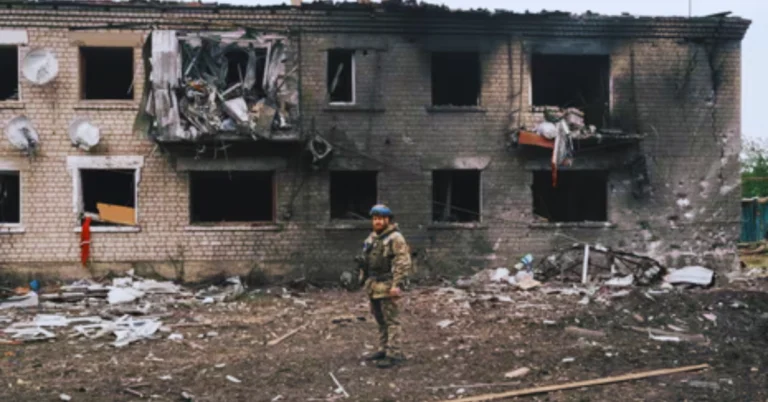The ongoing war between Russia and Ukraine has been marked by extreme military maneuvers, territorial advances, and geopolitical ramifications. The latest escalation, where Russia focuses its efforts on an important Ukrainian town whilst Ukraine’s incursions are sluggish within the Kursk area, highlights the complexity of the war. This essay will discover the significance of Russia’s today’s army push, the consequences of the slowing Ukrainian advances, and the broader context of the battle’s evolving dynamics.
Russia’s Strategic Focus on a Key Ukrainian City
Russia’s renewed cognizance of a key Ukrainian metropolis alerts a shift in its navy approach. This metropolis, doubtlessly one of the significant strategic costs because of its region, infrastructure, or symbolic significance, represents a vital goal for Russian forces. By concentrating their efforts here, Russian forces may also intend to secure a pivotal victory that could offer both a tactical gain and a mental boost. The seizure of this kind of metropolis could disrupt Ukrainian delivery strains, weaken morale, and solidify Russian control over contested areas.
The desire of this particular city is probably influenced by the aid of an aggregate of navy, political, and economic elements. Militarily, controlling this region could permit Russia to set up a more potent foothold in Eastern Ukraine, permitting further advances or the consolidation of occupied territories. Politically, shooting a big city is probably utilized by the Kremlin to demonstrate progress to home audiences, reinforcing the narrative that the “special navy operation” is yielding effects. Economically, the city should keep key assets or infrastructure, along with transportation hubs or commercial facilities, which can be crucial for sustaining the battle effort.
Slowing Ukrainian Incursions in Kursk: A Tactical or Strategic Pause?
While Russia intensifies its assault in this Ukrainian metropolis, reviews imply that Ukrainian forces have slowed their incursions within the Kursk region. This development raises questions about the reasons behind the slowdown and its implications for the wider struggle.
One possible explanation is that the Ukrainian army is experiencing logistical demanding situations or is regrouping after maintaining big losses. The nature of cutting-edge warfare, with its reliance on delivery chains, communications, and coordination, way that any disruption can result in a transient halt in operations. Alternatively, the slowdown might be a planned strategic pause, permitting Ukrainian forces to re-evaluate their techniques, collect intelligence, or prepare for an extra focused push in another region.
Another aspect to take into account is the function of outside help in Ukraine’s navy operations. Western navy useful resources, intelligence sharing, and schooling had been important in bolstering Ukrainian defenses and permitting counter-offensives. A slowdown in incursions could signal a temporary reduction in this support or a shift in cognizance in the direction of other fronts wherein Ukrainian forces may also have a better hazard of success. The Kursk vicinity, being in the direction of the Russian border, offers particular challenges for Ukrainian forces, including the threat of deeper Russian counterattacks and the complexities of operating in a heavily fortified place.
The Broader Context: Evolving Dynamics and Geopolitical Implications
The developments in Ukraine, consisting of Russia’s push on a key town and the slowing Ukrainian advances, are part of a broader, evolving battle that has ways-achieving implications past the instant battlefield. The warfare in Ukraine isn’t always only a conflict between two international locations but a focal point of global geopolitical tensions, with NATO, the European Union, and other worldwide actors deeply worried.
Russia’s method seems to be more and more centered on securing territorial profits that may be leveraged in destiny negotiations or, failing that, incorporated into the Russian Federation. The emphasis on shooting extensive city facilities and key infrastructure suggests an extended-term plan to reshape the map of Ukraine in Russia’s prefer. This approach, however, dangers similarly entrenching the warfare, main to a protracted war without a clear decision in sight.
On the other hand, Ukraine’s capability to keep stress on Russian forces, despite the challenges, underscores its resilience and the effectiveness of its worldwide partnerships. However, the slowing of incursions, especially in strategically sensitive areas like Kursk, highlights the limits of Ukraine’s army ability and the capacity for fatigue in a battle that indicates no signs of abating.
Conclusion
The present-day section of the Russia-Ukraine battle, marked with the aid of Russia’s push on a key Ukrainian town and the slowing of Ukrainian incursions inside the Kursk region, illustrates the conflict’s dynamic and unpredictable nature. As both facets alter their strategies and adapt to the changing realities on the ground, warfare remains a complex and multifaceted battle with profound implications for the place and the world. The outcome of those maneuvers will not simply shape the destiny of Ukraine but will additionally have an impact on the worldwide geopolitical landscape for years yet to come.
Read more: The Human Cost of War Impact of Russian Air Strikes on Kharkiv


